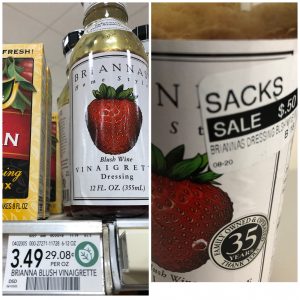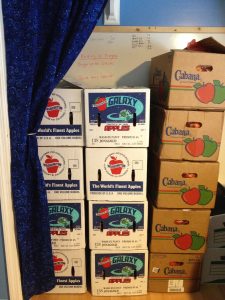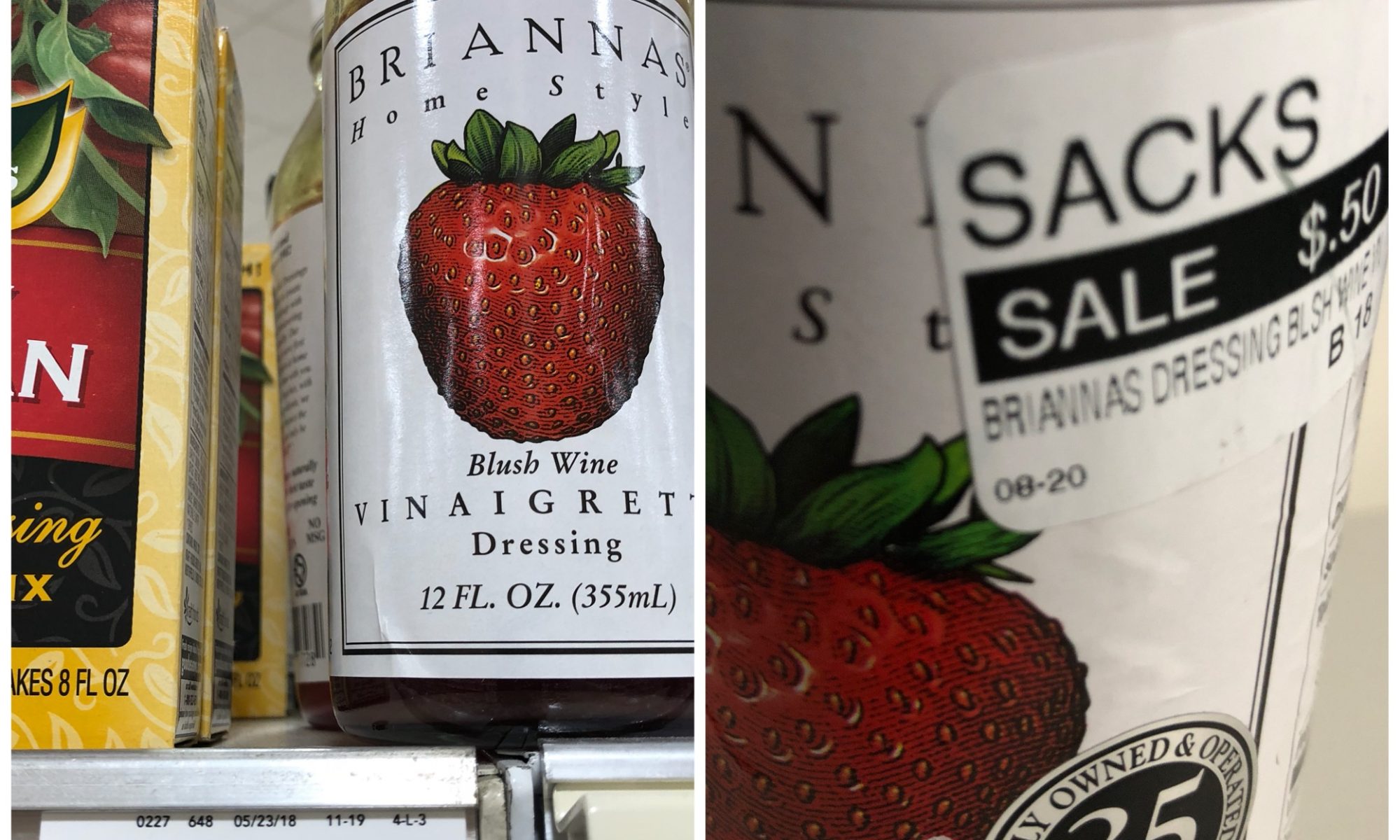For the previous posts in this series click Part 1, Part 2, and Part 3. This post contains affiliate links. If you make a qualifying purchase after clicking a link, we may receive a percentage of the purchase price.
When I was a child, my mother went grocery shopping every week or every two weeks. We went to the same store every time. Once in a while, we might go to an outlet store for bread. The Tightwad Gazette by Amy Dacyczyn (Amazon affiliate link) introduced me to the idea that if your goal is the lowest possible price, you must shop at multiple stores.
Why shop at multiple stores?
No store has the lowest price on every single product in the store. The regular price of items will vary depending on arrangements with the product manufacturer or supplier, how quickly products turn over in that location, and many other factors.
Different stores have different items on sale every week. Even if the regular price at Store A is the lowest usual price, the sale price at Store B may be the lowest ever price.
Sale items are often ‘loss leaders’ for the store. A loss leader is an item that is sold below the price the store pays to buy that item in order to stock it in the store. Every time the store sells that item, they lose money on it.
Stores use loss leaders as a way to get you into the store, believing that once you are there, you will buy enough other items that they will still make a profit on your overall purchases. When an item is a loss leader, that sale price may be the lowest you will ever see for that particular item.
Finally, your local chain grocery store is not your only option. If you take a broader look at the stores available to you, you have a better opportunity to find lower prices on the items you purchase.
Consider your shopping options
If you have always shopped at one grocery store, perhaps you have never looked further than whatever store is closest to your house. Here’s some store categories to investigate when looking for your least expensive food options.
Grocery Chains
This category includes everything from discount grocery stores (e.g. Aldi) to whatever your usual mid-level chains might be to high-end chains like Whole Foods.
I go to Publix, a Florida-based grocery chain, at least once a week. No matter which route you take out of our neighborhood, you will pass a Publix. We have 4 stores within 4 miles of our house, one of which is a mile away and another of which is two miles away from our house. These two locations are on opposite ends of the road that bisects our subdivision. We go to Publix for those items we can only get in a grocery store, to pick up items we ran out of and need now, to get prescriptions filled, etc. They have weekly BOGO (Buy One Get One) free sales, so I may go there to stock up if something we use is on BOGO. Unless I’m getting BOGO deals, we shop with a handheld basket, not a cart, and we are checking out in the 10 items or less line.
I go to Whole Foods every few weeks or so. Whole Foods is about 6 miles from our house, but in a direction we rarely go. This location only opened a year or two ago; before that, the nearest Whole Foods was 15 miles from our house and we never went there. Now we go mostly for specific dietary supplements and gluten-free bread. When we are there, we look to see what’s on sale because, as Amazon Prime members, we get an additional 10% off the sales price (Amazon affiliate link).
Superstores
These are stores like Target and Walmart that have a grocery section in addition to clothing, household items, electronics, and more.
Target and Walmart are both conveniently located for me, across the street (in different directions) from Costco. However, I almost never go to these stores for any reason so have not been making the extra effort to look at their grocery sales.
The Walmart near Costco is a small store, with a limited grocery selection. We do have two other Walmart options — a Neighborhood store, which is Walmart’s groceries-only chain, opened four months ago three miles from our house, and a true Superstore with a full grocery store located five miles from our house in the opposite direction from Costco. The Neighborhood store is smaller than our Publix options, but does have good prices on some things we buy regularly and it is very close. I will be making an effort to get there at least once a month.
Stores specializing in specific regional cuisines
Chris and I like many cuisines from around the world. Large national chains tend to have a limited selection of ingredients from a limited range of brands for a limited range of world cuisines. If you want a full range of ingredients, you are better off shopping at stores that specialize in whatever cuisine you want to make.
Since these stores specialize and primarily cater to people who are making the day-to-day food of their heritage, the turn over on products is better than in the national chains. Not only will the range of ingredients be better, higher turn over means fresher products, and the prices are almost always better than what you find in the national chains.
I just recently started doing regular fruit and vegetable shopping at a local chain called Fancy Fruit and Produce. I buy produce at Costco also, but only things that will last a while or which we use quickly. Almost everything else, I get at Fancy Fruit and Produce. As the name implies, they are a specialty shop for produce. They are also a specialty shop for Latin ingredients and, to a lesser extent, for Asian ingredients. This is reflected in the wide selection of produce — I have not been in any other shop, even the other Latin shops in my area, that sells nopales — but also in their dry goods, meat, refrigerated items, frozen section, and bakery. Fancy Fruit in Produce is 3 miles from my house, on the way home from Costco, so it is an easy place to stop and I go there a couple times a month.
In addition to Fancy Fruit and Produce, I regularly visit specialty shops for Indian and Asian ingredients. I used to visit a Middle Eastern shop also, but it went out of business and I have not yet found a replacement in my area. The best Indian shop in the Orlando area is Patel Brothers, a chain with 52 stores in the eastern part of the United States. Unfortunately, it’s a 45 – 60 minute drive from my house, so I do not go as often as I would like.
The Asian grocery stores are maybe 10 miles from my house and along my driving route to / from my monthly spinning group meeting. Despite this I do not stop very often because I am able to get the majority of the ingredients I need at Publix, Costco, Fancy Fruit and Produce, or online. As a result, I visit the Asian specialty stores once every six months or so.
Warehouse Stores
In the United States, the three largest warehouse chains are Costco, Sam’s Club, and BJ’s. At these stores, you pay an annual membership fee for the privilege of shopping there. Products are all sold in bulk, meaning you must buy a large quantity at a time.
I do the majority of our household shopping at Costco. Yes, we are a two person household. It’s still worth it. I do a major shopping at Costco once every 4-6 weeks, with visits in between to get things we forgot or need to replenish. Costco is only 4 miles from my house, so it is quite convenient to get there. We drive by it regularly on other trips, so can and do stop in for a single item if we need it.
Farmers’ Markets
If you are looking for fresh produce, locally raised eggs or meat, or locally processed foods like jams, your local farmers’ market is a great place to visit. Often the produce was picked that morning or the day before. You get to talk to the farmer. The money you spend on food goes directly to the person who grows it, without middlemen. The combination of price and quality can’t be beat!
In the past I’ve done a lot of shopping at Farmers’ Markets. However, the options that are currently convenient to me are not robust. The majority of the stalls are artisan foods, not people raising produce or animals. As a result, I do not regularly shop at any farmers’ markets.
Online retailers
Many items can be purchased at good prices online, with free shipping if you meet minimum purchase requirements. Several companies offer spices online (my favorite is The Spice House because they sell reasonable sizes for household use, offer free shipping with a minimum order, and have excellent quality products). Walmart, Amazon.com, and Costco (as well as many other retailers) offer a wide variety of products with free delivery once you meet the minimum purchase price.
At Amazon.com, you get a discount off their regular price with “Subscribe and Save,”(Amazon affiliate link) a service that will ship products to you on whatever schedule you choose. This is particularly useful for those products you know you will have to replenish regularly — toilet paper, diapers, cleaning supplies, etc. You can pick a different quantity and schedule for each product. This eliminates two of the common concerns people have with some of these shopping strategies — you do not have to spend time and gas driving to multiple stores and you don’t have to worry about storage space. The concept here is something that many businesses have done for years — Just In Time ordering, to minimize inventory but still get the best possible price.
I currently Subscribe and Save to two items — toilet paper and cleaning solution for our tile cleaner. I get about 15% off Amazon’s regular price on each of these items. The regular price plus discount is less than the regular price at my local shops. I used to Subscribe and Save to the powdered broth mix my mother-in-law used and I had that shipped directly to her. When she passed away, I stopped that subscription. I am currently evaluating Subscribe and Save items to see if it is a good option for any other products we purchase.
Manufacturing facilities
Many food manufacturing facilities have small shops open to the public where they sell products at prices far lower than you will find anywhere else. For many years, the Merita Bread Company baked bread at a factory in Orlando. I used to go there to buy bread for 1/2 the price that it sold for at Walmart, which had the lowest price of any local retailer. Unfortunately, the local factory closed when Hostess bought Merita several years ago. I still miss the smell of fresh-baked bread wafting over I-4 when driving by that factory!
Since Merita Bread Company closed, I am not aware of any other local food manufacturing facilities with shops open to the public. If you’re an Orlando local and know of something, I’d love to hear about it!
Outlets and Liquidators
These stores sell products that may be past their sell by date or that are scratch and dent products. The shopping experience and product quality varies dramatically, depending on the store.
Outlets usually specialize in a specific brand name. The most common outlet stores seem to be those for breads and related baked goods. The selection is usually stable and the physical condition of packaging and product is high.
A liquidator, on the other hand, will have a wider variety of products, but the specific selection will not be the same from one visit to the next. The condition of packaging and product varies significantly from product to product, package to package, and visit to visit.
I used to shop regularly at Sacks, a local liquidator, because it was on my drive home from work. That shop hasn’t been on my way home from work for more than 10 years now. It is perhaps 8 miles from our house, but along a route we almost never take for any other reason. Since it would now require a special trip, I haven’t gone in years.
Yesterday, I happened to be driving by the store, so I stopped to see what they had. I remembered both why I used to shop there regularly and why I have not been making a special trip to go there. Despite not visiting the shop for years, I only bought four items — 2 bottles of Brianna’s Blush Wine Vinaigrette and 2 packages of spiralized zucchini. The salad dressing was $0.50 / bottle ($3.50 at Publix) and the zucchini was $1.00 for a 12 oz package ($6 / pound for a similar product at Publix). Obviously, the prices can’t be beat and that’s why I used to shop there regularly.

The reason I have not been making a special trip to go there is that there’s rarely enough quantity of things I buy to make a special trip worthwhile. The nature of this company means that selection will vary — I may never see another bottle of Brianna’s Blush Wine Vinaigrette in their store. Many of their products are ones I will not buy, not just because they are products we do not use, but also because of the condition of the packaging. I have no problem buying the canned or bottled products there, but am wary of anything that comes in a box or bag. I may buy items from the refrigerated section, but am suspicious of the freezer section.
After yesterday’s visit, I think the considerable savings will make shopping there worthwhile. I am thinking that I may start going to Sacks once a month, on days I’m planning to do a larger shopping trip at Costco. Sacks is only 3 miles from Costco so combining the two into one trip improves the time and gas efficiency.
Wholesalers and Distributors
This category refers to the middlemen in our food system. They aren’t manufacturing or raising food. They are acquiring food from growers or manufacturers, then selling to the food industry.
Many of these companies require their customers to have food-related businesses and associated licenses and therefore do not sell to the public. However, some of them will sell to the public. If there’s something you want to buy in large quantities, it is worth the effort to look up your local wholesalers and distributors and give them a call!
I like to can things. I’ve canned applesauce, marinara sauce, jams, cranberry sauce, peaches, and more. We do not have a garden and do not have easy access to growers for many products. One solution for me is Todd’s Tomatoes, a local produce wholesaler. I’ve purchased both tomatoes and apples from them to turn into sauce, and will be getting tomatoes from them later this year when it gets cool enough that I’m not going to melt when standing outside stirring the marinara.

Common Concerns with Shopping at Multiple Stores
The most common concerns people have with shopping at multiple stores is that it will take too much time to organize food shopping before you go and too much time to visit all these stores and it will cost so much in gas that it isn’t worth it to visit all these stores.
On Time
The penultimate post in this series is about time and calculating the value of the time you spend on all of these strategies, so I’m going to leave a detailed discussion until then. For now, let me just say that, like all the strategies described so far, this one may take some time to set up, but can save time in the long run.
How many stores you visit and how often you visit them is up to you and adaptable to your circumstances. You do not have to go to all of these stores every week or every two weeks or even every month. You may not have all of the listed options available to you.
Regardless of whether these different stores are local to you or if you need to drive a long distance to get to one, you do not need to go out of your way to shop at different stores. Start by researching what is along your usual driving routes to work or school or whatever. Make the easiest changes first and build from there.
On Gas
You can determine how much money you will spend on gas to get to a store and figure out if the purchases you make there save enough money to at least cover your gas. Price per gallon / miles per gallon = price per mile * number of round trip miles to get to the store = how much you’ll spend in gas. Or you can look up the IRS standard mileage rate for business deductions, which is calculated to include the price of all operating costs, including gas, maintenance, and wear and tear. For 2018, the IRS standard mileage rate is $0.545 / mile.
When calculating the vehicle cost of a shopping trip, be sure to only include the mileage specific to that trip. If I combine a trip to Sacks with a trip to Costco, the mileage attributable to Sacks is only the distance between Sacks and Costco, not the distance between Sacks and my house.
Let’s look at the cost of a trip to Sacks, using both calculations. $2.70 / gallon of gas / 25 mph = $0.108 / mile * 6 miles (round trip) = $0.65 (rounded to nearest penny). Using the IRS rate, the marginal rate of adding Sacks to a Costco trip is 6 miles (round trip) * $0.545 =$3.27.
Apply Your Own Value Judgments
The amount saved on the salad dressing, a product I regularly purchase, was a total of $6.00. The amount saved on the zucchini, a product I had not purchased before due to the high cost and which I am unlikely to purchase again in the future, is $10.35. The total savings for the trip is $16.35.
Once you have the data, apply your own value judgments. Which way of calculating the vehicle cost makes the most sense to you? Do you consider the amount saved only on products that you regularly buy? Or would you count the $2.00 spent on the zucchini as a negative because it is money I would not have spent otherwise?
Depending on how you make these value judgments, I saved somewhere between $0.73 ($6 saved on regular price of salad dressing – $3.27 operating cost of vehicle – $2 spent on product I shouldn’t have bought) and $15.70 ($16.35 total savings – $0.65 cost of gas) during my visit to Sacks. Neither of these extremes, nor the intermediate options on the scale between them, are incorrect ways of weighing the data.
Remember our ultimate goal here is food that (1) tastes good and (2) promotes health (3) at the lowest possible cost, with an eye to the (4) time it takes to procure, prepare, and clean-up our food. Each these four points involves value judgments and different people will weigh options differently. What I am trying to do is provide some tools that help you to weigh all your options so you are meeting that goal in the best possible way for your family.

